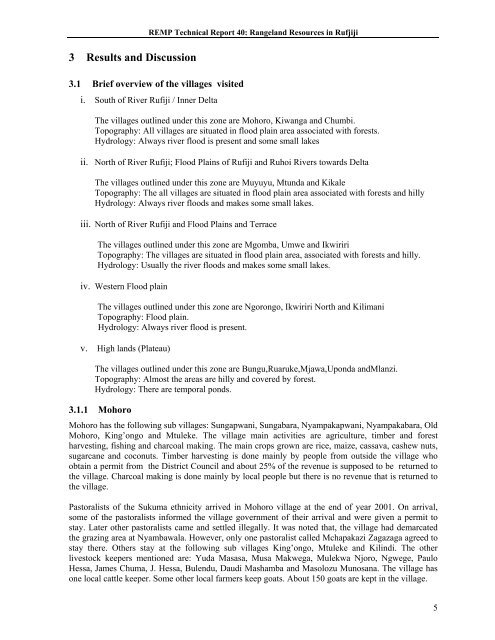rufiji environment management project - Coastal Forests of Kenya ...
rufiji environment management project - Coastal Forests of Kenya ...
rufiji environment management project - Coastal Forests of Kenya ...
You also want an ePaper? Increase the reach of your titles
YUMPU automatically turns print PDFs into web optimized ePapers that Google loves.
3 Results and Discussion<br />
REMP Technical Report 40: Rangeland Resources in Rufjiji<br />
3.1 Brief overview <strong>of</strong> the villages visited<br />
i. South <strong>of</strong> River Rufiji / Inner Delta<br />
The villages outlined under this zone are Mohoro, Kiwanga and Chumbi.<br />
Topography: All villages are situated in flood plain area associated with forests.<br />
Hydrology: Always river flood is present and some small lakes<br />
ii. North <strong>of</strong> River Rufiji; Flood Plains <strong>of</strong> Rufiji and Ruhoi Rivers towards Delta<br />
The villages outlined under this zone are Muyuyu, Mtunda and Kikale<br />
Topography: The all villages are situated in flood plain area associated with forests and hilly<br />
Hydrology: Always river floods and makes some small lakes.<br />
iii. North <strong>of</strong> River Rufiji and Flood Plains and Terrace<br />
The villages outlined under this zone are Mgomba, Umwe and Ikwiriri<br />
Topography: The villages are situated in flood plain area, associated with forests and hilly.<br />
Hydrology: Usually the river floods and makes some small lakes.<br />
iv. Western Flood plain<br />
The villages outlined under this zone are Ngorongo, Ikwiriri North and Kilimani<br />
Topography: Flood plain.<br />
Hydrology: Always river flood is present.<br />
v. High lands (Plateau)<br />
The villages outlined under this zone are Bungu,Ruaruke,Mjawa,Uponda andMlanzi.<br />
Topography: Almost the areas are hilly and covered by forest.<br />
Hydrology: There are temporal ponds.<br />
3.1.1 Mohoro<br />
Mohoro has the following sub villages: Sungapwani, Sungabara, Nyampakapwani, Nyampakabara, Old<br />
Mohoro, King’ongo and Mtuleke. The village main activities are agriculture, timber and forest<br />
harvesting, fishing and charcoal making. The main crops grown are rice, maize, cassava, cashew nuts,<br />
sugarcane and coconuts. Timber harvesting is done mainly by people from outside the village who<br />
obtain a permit from the District Council and about 25% <strong>of</strong> the revenue is supposed to be returned to<br />
the village. Charcoal making is done mainly by local people but there is no revenue that is returned to<br />
the village.<br />
Pastoralists <strong>of</strong> the Sukuma ethnicity arrived in Mohoro village at the end <strong>of</strong> year 2001. On arrival,<br />
some <strong>of</strong> the pastoralists informed the village government <strong>of</strong> their arrival and were given a permit to<br />
stay. Later other pastoralists came and settled illegally. It was noted that, the village had demarcated<br />
the grazing area at Nyambawala. However, only one pastoralist called Mchapakazi Zagazaga agreed to<br />
stay there. Others stay at the following sub villages King’ongo, Mtuleke and Kilindi. The other<br />
livestock keepers mentioned are: Yuda Masasa, Musa Makwega, Mulekwa Njoro, Ngwege, Paulo<br />
Hessa, James Chuma, J. Hessa, Bulendu, Daudi Mashamba and Masolozu Munosana. The village has<br />
one local cattle keeper. Some other local farmers keep goats. About 150 goats are kept in the village.<br />
5

















